Asus Radeon 9600XT/TVD Review
Asus Radeon 9600XT/TVD
If you can't afford a Radeon 9800XT, the 9600XT could be the answer. But how does it compare to its big brother?
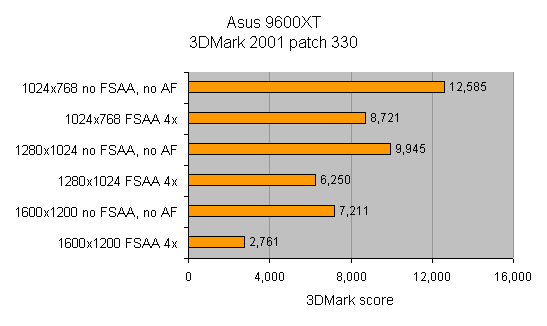
Verdict
Key Specifications
- Review Price: £142.00
If you’re a gamer at heart, you’ll probably be salivating over the prospect of owning a supercharged powerhouse such as the Asus Radeon 9800XT. However unless you eat caviar for breakfast, or are just plain filled with ‘got to have it’ graphics-power lust, you’ll soon find yourself breaking into a cold sweat at the thought of the £350 plus price tag.
The solution to this conundrum could well be the Asus 9600XT, which at £163 is nearly one-and-a-half times cheaper than its big brother. The card offers all the key features of the 9800XT such as full DirectX9 support, Smoothvision 2.1, for image enhancing anti-aliasing and anisotropic filtering, and Hyper Z III, which is designed to make the most efficient use of memory bandwidth.
The 9600XT chip is in some respects more advanced than its faster and far more expensive sibling. It’s manufactured using a 0.13 micron process rather than the older 0.15 micron process of the 9800XT. A smaller micron process means lower power requirements and higher clock speeds. This has enabled ATi to clock the VPU at 500MHz, 88MHz faster than the 9800XT. The memory is clocked at 600MHz DDR, 140MHz less than the 9800XT, while a 128bit bus means that the flow of data between the VPU and the memory isn’t as speedy as on the 256bit 9800XT.
So what does Asus bring to the 9600XT party? If you want to squeeze more out of the card you can use the supplied overclocking utility called SmartDoctor to shift the VPU up to 530MHz and the memory up to 650MHz. This also enables dynamic throttling of the fan speed so you can lower the ambient noise when you don’t need to stress the VPU. This features can’t however be used in conjunction with overclocking. However, Asus’ efforts at delivering a custom design heatsink and fan combination works well and the noise isn’t as loud as my GeForce4 Ti4600.
As a side note I found that the card would lock-up in games when run in my overclocked motherboard. Dropping the motherboard down to stock speeds solved the problem. By way of comparison, the Asus 9800XT exhibited no such shyness at running in an overclocked system.
The Asus stands out from the competition by offering both video in and video out capabilities. This is thanks to the presence of an integrated Rage Theatre Video chip, as used in the All-in-Wonder line. A break-out box is supplied to give easy access to the various connections.
Inside the box you’ll find a voucher entitling you to a free copy of Half Life 2 when it arrives. Although the voucher is only valid for the single player version. There’s also a CD case with the full versions of the DX9 game Gun Metal and Battle Engine Aquila
So how about performance? In 3DMark 2001, its score of 12,585 at a resolution of 1,024 x 768 means that it will breeze through older DirectX7 games. Its 3DMark03 score of 3644 is also an improvement over the score of an Atlantis 9600 Pro board, which achieved 3252.
The limitations of the 9600XT will only come to the fore if you push the resolution too high. In the Unreal Tournament 2003 flyby test, the 9600XT was able to reach a very comfortable 69.5fps at 1,280 x 960 even with anti-aliasing and anisotropic filtering turned on. However, pushing it to 1,600 x 1,200 with everything turned on, and the memory bandwidth limitations of its value-conscious architecture become apparent – the score drops to 26.1fps compared to the 75.2fps of the 9800XT. In the demanding Gun Metal benchmark the frame-rate was an unplayable 9.9fps at 1,600 x 1,200 and could only hit 21.4fps at 1,024 x 768.
Our game play testing bore out the benchmark findings. We were able to have a lot of fun with the 9600XT, as long as we kept the resolution and image quality enhancing features down to sensible levels. However on an Athlon XP 2500+ based system playing the latest state-of-the-art shooter Halo was satisfactorily smooth only at a resolution of 800 x 600.
Clearly, if you want to play upcoming games at high resolutions with all the image quality features turned on, you’ll have to dig deeper for a card costing over £200. If you don’t want to spend that you will be able to obtain smooth frame rates and DX9 effects in current games such as Halo as long as you keep the resolution and image quality settings at reasonable levels. If you’re satisfied with that, then the Asus 9600XT is a solid buy.
”’Verdict”’
Asus delivers a quality package with a gaming bundle, decent software utilities and a custom heatsink/fan design. A Sapphire 9600XT is £20 cheaper but with video-in as well as TV-out the Asus is a good value proposition

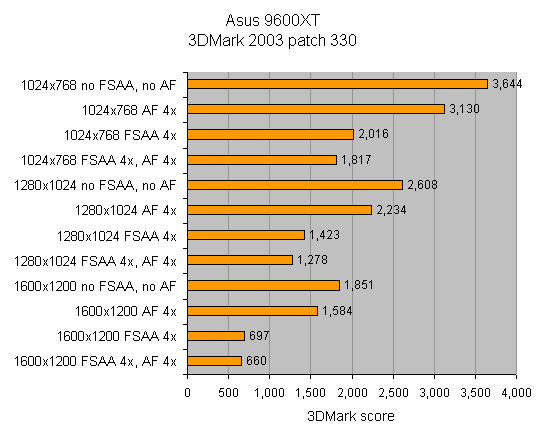
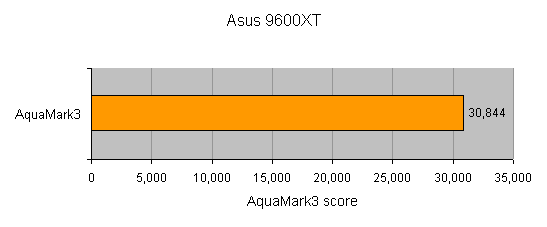
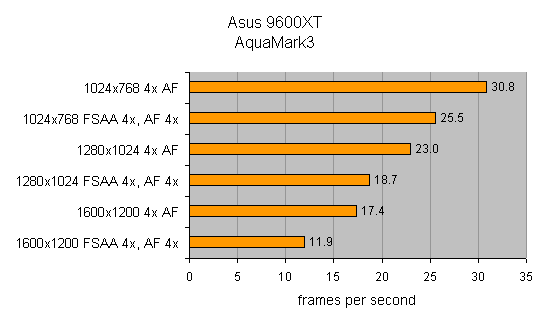
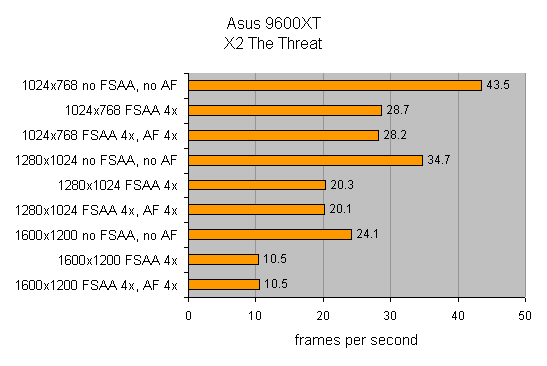
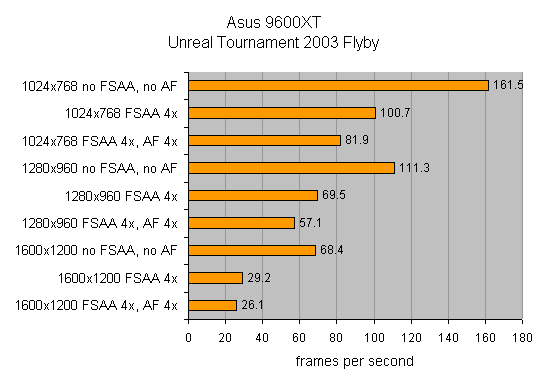
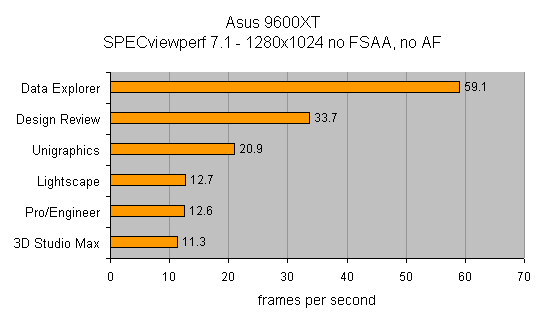
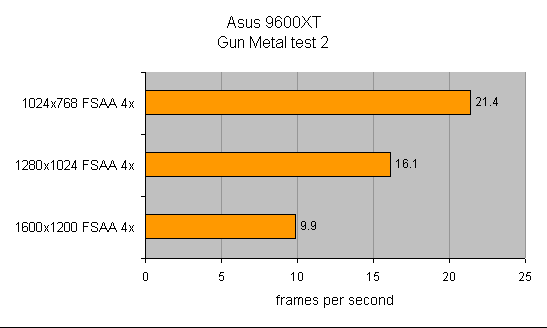
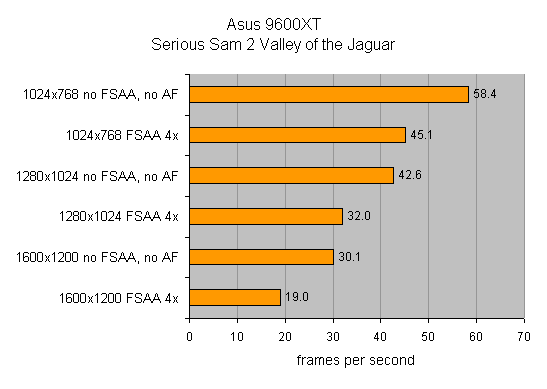
Trusted Score
Score in detail
-
Value 9
-
Features 8
-
Performance 8

